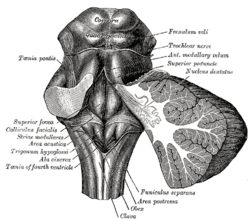Locus ceruleus
| Locus coeruleus | |
|---|---|

Rhomboid fossa. (Locus coeruleus not labeled, but is very near [just lateral to] colliculus facialis, which is labeled at center left.)
|
|

Micrograph showing the locus coeruleus. HE-LFB stain.
|
|
| Details | |
| Identifiers | |
| Latin | locus caeruleus ("blue place") |
| NeuroNames | hier-578 |
| NeuroLex ID | Locus coeruleus |
| TA |
A14.1.05.436 A14.1.05.706 |
| FMA | 72478 |
|
Anatomical terms of neuroanatomy
[]
|
|
The locus coeruleus (\-si-ˈrü-lē-əs\, also spelled locus caeruleus or locus ceruleus) is a nucleus in the pons (part of the brainstem) involved with physiological responses to stress and panic.
The locus coeruleus is the principal site for brain synthesis of norepinephrine (noradrenaline). The locus coeruleus and the areas of the body affected by the norepinephrine it produces are described collectively as the locus coeruleus-noradrenergic system or LC-NA system. Norepinephrine may also be released directly into the blood from the adrenal medulla.
The locus coeruleus (or "LC") is located in the posterior area of the rostral pons in the lateral floor of the fourth ventricle. It is composed of mostly medium-size neurons. Melanin granules inside the neurons of the LC contribute to its blue color. Thus, it is also known as the nucleus pigmentosus pontis, meaning "heavily pigmented nucleus of the pons." The neuromelanin is formed by the polymerization of noradrenaline and is analogous to the black dopamine-based neuromelanin in the substantia nigra.
In adult humans (19-78) the locus coeruleus has 22,000 to 51,000 total pigmented neurons that range in size between 31,000 and 60,000 μm3.
The projections of this nucleus reach far and wide. For example, they innervate the spinal cord, the brain stem, cerebellum, hypothalamus, the thalamic relay nuclei, the amygdala, the basal telencephalon, and the cortex. The norepinephrine from the LC has an excitatory effect on most of the brain, mediating arousal and priming the brain’s neurons to be activated by stimuli.
...
Wikipedia
